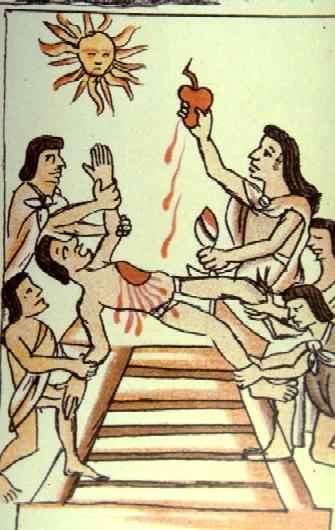|
Human SacrificeWhat better way to show God you appreciate him than to squander his most precious gift, life, in a miasma of ruthlessness and gore?In addition to justifying Crusades, Witch Trials and Wars, this theological breakthrough is also the main justification for the time-honored practice of human sacrifice.
The original theory was "everyone needs to eat," including the ancestor-gods. So priests would dutifully leave food sitting out for the gods, who would never actually eat the food. It was embarrassing to have all this food sitting around, so the priests eventually began burning, cutting or bleeding the sacrifices instead of just leaving them out to rot. As time went on, the original theory of feeding the gods was forgotten and the practice became a ritual which was essentially meaningless to its participants (like the use of chrism in a Christian baptism, just for example). The first sacrifices consisted of food and meat, but the emphasis slowly shifted to animal sacrifice and from there to blood sacrifice. Once you've moved past the notion that you're actually feeding the gods, an animal hierarchy kicks in, so a goat is a better sacrifice than a chicken, and a cow is better than a goat. So what would be the bestest sacrifice of all? Eureka! There is some controversy about when the practice of human sacrifice actually began. Some argue for a prehistoric origin, but the evidence for these claims unfortunately tend to be 10,000-year-old bodies found in Northern European bogs, which leaves room for a not-insignificant amount of interpretation. There's a better than even chance those bodies were the result of early executions or ritual killings, among all of which there is an admittedly fine line. Human sacrifice is more or less defined here as the ritual killing of a person to appease or coerce a god figure.
Virtually every culture and region has a history of human sacrifice, from the Romans to the Celts to the Aztecs... Hell, even the Dutch. The ancient Greeks sacrificed humans to the goddess Artemis, including the famous sacrifice by Agamemnon of his favored daughter. This tale was later likely plagiarized by the Jews as the story of Abraham, who is ordered by Yahweh to sacrifice his beloved son, Isaac. In the Hebrew version, however, the whole gig is just a trick to see if Abraham would really go through with it. God has a good laugh at Abraham's expense, and everyone lives happily ever after. In the Middle East, the traditional human sacrifice was usually accomplished with a blade, and the blood of the sacrificed individual was collected as part of the ritual. This approach was positively humane compared to some other cultures. Methodology could vary dramatically depending on the geographic regions. In Northern Europe, victims were frequently overkilled, much like Rasputin, with corpses found stabbed in the back, strangled, with their heads bashed in and finally drowned in a bogs. The Celts are famously rumored to have burned victims to death in a giant wicker man, inspiring the 1973 thriller of that name. There were (and to an extent, still are) many different traditions of human sacrifice practiced on the continent of Africa. One especially grisly form, known as "muti" killing, involves dismemberment and decapitation, the removal of vertebrae and/or genitals, and draining of blood from the corpse. The overall effect of the practice is more or less to bring good fortune for the sacrificer by taking it away from the sacrificee. Removed parts may be further dissected for specific uses.
Various Hindu cults enjoyed a nice sacrifice every now and again, and some still do. The sacrifices were intended to honor the goddess Shakti, an incongruously maternal figure who showed her motherly love by asking her followers to gut and bleed each other. The cult of Kali would routinely sacrifice virgins (both boys and girls) by cutting off their hands, breasts and feet. Anti-Semites frequently cite an old libel that the blood of Gentile children is used to make matzo bread. Anyone with experience breadmaking will tell you that the rapid coagulation of blood makes it pretty useless as a baking ingredient, but the whispered slurs recur every few decades nevertheless. In Prague, the rumors were so pernicious that a mystical warrior was reputedly summoned through the power of Jewish magic to banish them once and for all. (This PR campaign failed when the warrior instead embarked on a murderous rampage.) Human sacrifice in the Western Hemisphere continued much later than it did in Europe, Asia and the Middle East. One find unearthed hundreds of corpses of fishermen in Peru who had been killed around the 14th century in the ancient equivalent of execution style bound, on their knees and stabbed through the heart. While all these variations provide fun for the whole family, it's really the Incas and Aztecs of South America who elevated human sacrifice into the art form we all know and love today. The Incas sacrificed women and children using several different methods, but the Aztecs were the ones who really had a sense of style. So FUCK that drowning-people-in-bogs shit. The classic example of Aztec sacrifice is immortalized in the image of a robed priest cutting the beating heart out of a living chest at the very apex of a pyramid, blood gleaming in the tropical sun as it ran down the massive stone structure's step-tiers. The Mayans also employed this method—perhaps to help the odds of their apocalypse-predicting calendar—but they also had more commonplace rituals in which priests would bleed themselves sub-fatally over a sacred location. Because the languages of indigenous South American tribes have mostly been lost, it's difficult to really determine what they were thinking about the rationale for these sacrifices, but they appear to have some astronomical significance (as almost everything associated with a pyramid eventually will). Some scholars believe the sacrifices were intended to ensure that the sun would keep on coming back every morning. It's understandable that this would be something of a priority, but entirely unclear what logic was used to connect the whole cut-out-the-beating-heart thing got to the whole sunrise-sunset thing.
The Shakti and Kali cults in India are still quite vibrant. Although they usually carry out faux sacrifices using animals, or effigies made from flour or pumpkins, the occasional human still slips through the system. In some of the more chaos-and-poverty stricken areas of African, periodic outbreaks reveal a lingering human sacrifice problem there as well, particularly in village settings in West Africa as well as areas so decimated by war that human life is invariably cheapened. Not that this strictly a Third World problem. Murders with overtones of sacrifice or "muti" ritual trappings pop up in places like London, New York, New Orleans and L.A. more frequently than you'd expect. Interestingly, the civil rights movement has not stepped in to defend the right of worshippers to sacrifice as they choose, despite the fact that the West's most popular religion is based around what was arguably the most spectacular human sacrifice in history.
Double standard? Well, maybe, but it does let the virgins sleep at night.
|
 Sacrifices are perhaps the most ancient method to honor deities, going right back to the earliest ancestor-worship religions of Egypt and Mesopotamia.
Sacrifices are perhaps the most ancient method to honor deities, going right back to the earliest ancestor-worship religions of Egypt and Mesopotamia.  The scholars don't really agree on where to draw the lines, but the bloodthirsty bastards have a marked tendency to designate just about any ancient death a "human sacrifice" for no defensible reason.
The scholars don't really agree on where to draw the lines, but the bloodthirsty bastards have a marked tendency to designate just about any ancient death a "human sacrifice" for no defensible reason. 
 Human sacrifice is still practiced all over the world today, but more discreetly than in the past. You don't hear much about still-beating hearts, but then the Incans and Mayans mysteriously disappeared several hundred years ago.
Human sacrifice is still practiced all over the world today, but more discreetly than in the past. You don't hear much about still-beating hearts, but then the Incans and Mayans mysteriously disappeared several hundred years ago.